The Zen of Weeding…
 I often recycle my old wicker laundry baskets for weeding chores. Not only are they inexpensive, lightweight and easy to move in and out of tight spots, but once they begin to fall apart, I can just break them up and add them to the compost pile!
I often recycle my old wicker laundry baskets for weeding chores. Not only are they inexpensive, lightweight and easy to move in and out of tight spots, but once they begin to fall apart, I can just break them up and add them to the compost pile!
As I sat down to write this article, I got a bit worried. It occurred to me that some inaccurate conclusions might be drawn from the working title. You might even think I am some kind of Martha (And we all know that I love Martha Stewart, but I’m no where near as tidy and organized –especially in the garden!). So before I get rambling, I want to make a few things clear. I do not regularly meditate, nor do I practice Zen. And I must confess that my garden is most definitely not an organized, tidy, weed-free zone. In fact it’s far from that ideal. You will probably find a bit of  crab grass in the walk, some jewelweed in my shade garden, and you will definitely spot plantain in my lawn. And right about now, the weeds in my perennial borders rival the flowers (OK, so I exaggerate, but you get the picture). So in case you were worried that I might start judging you, smugly preaching across the electro-static divide with my Cape Cod weeder held high… Well forget about it! I garden for a living, and this means I spend a great deal of time weeding my clients’ yards. So when I get home on a hot summer afternoon, I am no slave to my own. Of course this doesn’t mean that I allow my gardens to go wild. No, I would never let the scale tip too far in that direction. And no, this doesn’t mean I dislike weeding. But it does mean that I understand the average gardener very well. I’m one of you. We get busy. Things slide.
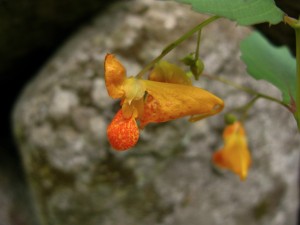 Spotted orange jewelweed (Impatiens capensis) in the Secret Garden. This is a hummingbird favorite. But I prefer it in the woods, not in my flower garden.
Spotted orange jewelweed (Impatiens capensis) in the Secret Garden. This is a hummingbird favorite. But I prefer it in the woods, not in my flower garden.
Weeding is a chore to most people. My design clients are always telling me that they haven’t the time for weeding, and I am constantly asked to create “no maintenance gardens” (if anyone has seen one, please let me know). And to tell the truth, I used to hate weeding. Really, I did. I found it boring, hot and tedious. But that was before I learned to time my weeding correctly and to truly give myself to the task. Now, once I start, I actually love the process of cleaning up my garden. Somewhere along the line, I suppose it dawned on me that gardening is weeding. Eventually, if you like to garden, you figure this out. And once you do, you “give” yourself to the process and let go of the product. The result of this surrender is usually a better maintained garden and a happier gardener. There is a Zen to weeding. In fact there is a Zen to all non-intellectual tasks, or ‘busy-work’ as some call it. Many people have a favorite ‘mindless’ task. Some of my friends love to do dishes by hand; calmed the circular motion of the sponge against the plate and the warm, soapy water. Others enjoy the drone of the vacuum cleaner and the back and forth motion on the floor. Repetition. There is freedom for the mind in physical repetition.
These days, I get some of my best ideas while weeding. As my mind slowly clears of day to day thoughts, things pop-up from my proverbial “back-burner”. I might remember my friend’s birthday, and think of a clever gift. Ideas for difficult design projects will suddenly spring to mind. With my front burners turned off, away from mental distractions, the back burner cooks. And then, slowly, something even more amazing happens. On my best days, my mind quiets to a whisper, and then becomes silent. Thoughts disappear and I simply become my hand, pulling weeds from the soil. If you have ever experienced this kind of “working meditation”, you know exactly what I mean, and how liberating it feels. Some people call this “the zone”. It happens when I am running. It happens when I am cleaning. And it happens when I am weeding. When I find myself in this magical state, I finish my garden chores in the most relaxed mood you can imagine. It’s great therapy, and I get a tidy garden as a bonus. Nothing clears my mind and relaxes my mood quite like the repetitive motion involved in pulling weeds.
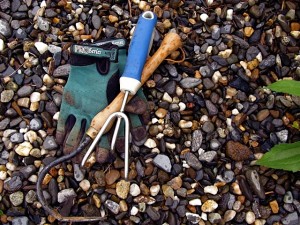 My weapons of choice: good gloves and quality tools. Here a Cape Cod weeder and Claw
My weapons of choice: good gloves and quality tools. Here a Cape Cod weeder and Claw
If you are new to gardening, you may not be familiar with “weeding bliss”, in fact right about now you may be thinking, ‘this woman has really slipped off the raft’. I can understand that. I used to feel the same way about weeding. And lest you start to think of me as some kind of monk, I want to be honest; there are days when the bugs and the heat are so distracting that I become far more irritated than illuminated. But nothing is perfect. And weeding is a practice. It’s something you can get good at and learn to like over time.
Arming yourself with some basic tools will help make weeding physically easier, and staying on top of the weeds will keep the task manageable. Every gardener ought to own a Cape Cod weeder, 3 tine cultivator, and a dandelion tool for hand weeding. A good hoe is necessary for the vegetable garden, and a standing cultivator (or claw), is great for large borders with deep-rooted perennials and shallow weeds. Make time to really learn how to use your tools. If you have never been taught how to properly hoe, ask a more experienced gardener to give you a lesson. Everyone starts somewhere, after all. And remember to take care of your body. Protecting your hands from thorns, stinging nettles and rough plants also makes a lot of sense. If you are uncomfortable, you will likely give up quickly. I try to apply moisturizer to my hands before I start working, and I wear durable, water-proof gloves. I like Womanswork brand gloves for everyday weeding chores, leather gloves for bramble-infested gardens, and Cool Mud for the really wet places. I always keep an extra set in my tote in case my gloves are soaked through or tear. And I protect my body with long sleeved shirts and pants as well. Bugs are always a problem here, and if you would like a few tips on dealing with them, check out my June post, ‘ Hey, BUG OFF! ‘. Remember to wear sunscreen anytime you are outdoors, and try a light-weight, wide brimmed hat to shade your head.
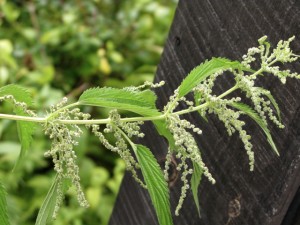 Stinging nettle (Urtica dioica) is best handled with gloves. Once exposed to heat, it’s actually a fine, gourmet edible!
Stinging nettle (Urtica dioica) is best handled with gloves. Once exposed to heat, it’s actually a fine, gourmet edible!
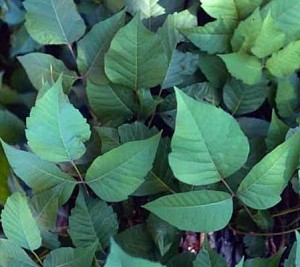 This is poison ivy, and you really want to avoid it altogether !
This is poison ivy, and you really want to avoid it altogether !
Of course, in order to start weeding, you have to know the difference between a weed and a desirable garden plant. So if you are just starting out, or returning to gardening, you may ask, ‘what exactly is a weed and how do I tell the difference’? Well, if you want to get technical about it, a weed is just a plant, (any plant), growing where it is unwelcome. Some North American gardeners loathe goldenrod (Solidago), and others welcome it as a native plant. To me, Queen Anne’s Lace is a beautiful flower in my meadow garden, and yet it crowds out vegetable seedlings in the potager, so there I consider it a weed. White clover makes a fantastic ground cover and lawn-substitute (and is a favorite food source of the honey bee), but when I see it popping up in my ornamental ground-cover and perennial borders, it gets a quick heave-ho. Likewise, I try to allow stands of jewelweed, in the wild parts of my property. Some more conventional gardeners may gasp in horror, but jewelweed is a delight to hummingbirds and honey bees, and an important food source. Keep in mind that many native plants (aka ‘weeds’), are part of our natural ecosystem. Removing weeds from your vegetable plot and perennial borders makes sense, of course. But keeping some natural areas is important to birds, butterflies and bees, if you can find the space.
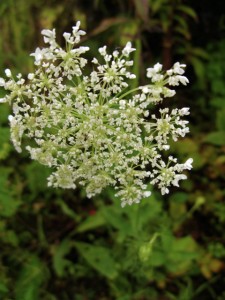 Queen Anne’s Lace (Daucus carota) is a biennial and spreads by seed. It’s great for attracting beneficial insects around the edges of a garden, or in a meadow.
Queen Anne’s Lace (Daucus carota) is a biennial and spreads by seed. It’s great for attracting beneficial insects around the edges of a garden, or in a meadow.
If you want to get really good at weed identification, keeping a reference book handy while you are working will really help. Try tossing one in your garden tote with a few tools. For the Northeast, I like the paperback, Weeds of the Northeast, by Uva, Neal and DiTomaso from Cornell University Press. The book covers North American regions including southern Canada, and points from Wisconsin eastward and Virginia northward. In fact, many of the weed identification charts would be helpful beyond these geographical parameters. For the west, Weeds of the West comes highly recommended and for the Great Plains states, Weeds of the Great Plains is available from the Nebraska Dept. of Agriculture. I picked up Weeds of the Northeast last year in response to an increased number of questions from my garden clients. Although I can identify most weeds, I do get stumped now and again, and I often have trouble remembering all of  the common and latin names (I have more than enough desirable plants in my gray-matter database to worry about). When I remember to put in in my pack, this reference book makes a great educational tool. In addition to identification, this book will help you learn the difference between annual and perennial weeds. If you catch annual weeds before they set seed, you will save yourself some work down the line. And as far as perennial weeds are concerned, you will need to take extra care in removing all of the roots, as well as any seeds. So, it’s good to know the difference.
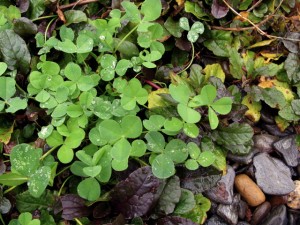 White clover (Trifolium repens), a perennial, here invading ground-cover ajuga. Clover is an important food source for bees. It makes a fine ground cover in relaxed areas, however you have to keep it in check or it will invadeyour beds & borders.
White clover (Trifolium repens), a perennial, here invading ground-cover ajuga. Clover is an important food source for bees. It makes a fine ground cover in relaxed areas, however you have to keep it in check or it will invadeyour beds & borders.
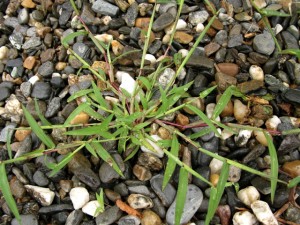 Large crabgrass (Digitaria sanguinalis), is a summer annual, it spreads by seed. This weed is common in lawns. I allow it to grow at the edges of my garden, because I enjoy seeing wild turkey, and they come to my meadow for the seed.
Large crabgrass (Digitaria sanguinalis), is a summer annual, it spreads by seed. This weed is common in lawns. I allow it to grow at the edges of my garden, because I enjoy seeing wild turkey, and they come to my meadow for the seed.
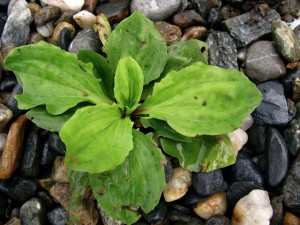 Broadleaf plantain (Plantago major), shown in my walkway, is also a common, perennial turf weed. This is handy to have around in the event of a bee sting. Just chew the leaves into a pulp and apply it directly to the sting. You should feel some relief in a few minutes.
Broadleaf plantain (Plantago major), shown in my walkway, is also a common, perennial turf weed. This is handy to have around in the event of a bee sting. Just chew the leaves into a pulp and apply it directly to the sting. You should feel some relief in a few minutes.
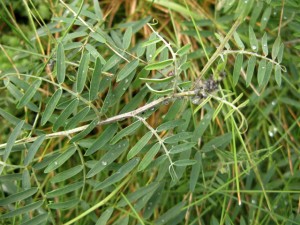 Vetch (Vicia cracca), is a perennial and spreads aggressively via rhizomes. This one is tough to fight, and not something you want in a perennial border. However, bees and butterflies love the flowers. Plant this on a slope and it will attract beneficials and prevent erosion.
Vetch (Vicia cracca), is a perennial and spreads aggressively via rhizomes. This one is tough to fight, and not something you want in a perennial border. However, bees and butterflies love the flowers. Plant this on a slope and it will attract beneficials and prevent erosion.
Some tricks to weeding are learned from experience. If you weed your garden thoroughly in spring, mulch with weed-free compost, and continue to pull weeds once a week through early summer, your garden should remain relatively manageable. When I go out weeding, I like to choose a spot and just start. I don’t focus on how much I need to do, or pause to figure out what is left to do, or how much has been done. I just stay right where I am and focus on the ground in front of me. This helps me to stay in the moment and to do a good job. I just grab the right tool and dig in. In my experience, removing most annual and tap-root weeds is easier either during or after a good rain. Conversely, I find that most running-root grasses are actually easier to remove when the weather is dry. A three pronged claw is great for teasing out the roots of running weeds like white clover, but a fork is the tool you want for tap-roots like dandelions. And remember that all garden chores are easier to do when the temperatures are cool and the sun is low. Try getting up a bit earlier and to start at first light, or make your weeding a sunset chore. Â The mid-day heat isn’t good for you, and it contributes to fatigue. Light weeding baskets (I recycle old wicker laundry baskets), wheelbarrows and garden carts are really helpful with many garden tasks, including weeding. Be sure your handles are sturdy and keep tires firm with air.
 Rabbitfoot clover (Trifolium arvense), is an annual spread by seed. I love seeing this plant in drifts along the roadside. It’s so pretty. But again, it doesn’t belong in my perennial garden.
Rabbitfoot clover (Trifolium arvense), is an annual spread by seed. I love seeing this plant in drifts along the roadside. It’s so pretty. But again, it doesn’t belong in my perennial garden.
Over time, I have learned to really enjoy the intimate garden experience that is weeding. Getting right smack in the middle of things brings me closer to the subtle smells, sights and sounds of the garden. I love working beside the bees, and getting buzzed by a curious hummingbird. The smell of wet earth, fragrant foliage and flowers is incredibly relaxing to me. And as an artist, I find that the shapes and textures of many ‘weeds’ are actually quite inspirational to my work. Sometimes, instead of tossing the contents of a basket straight into the compost heap, I find myself picking out bits of rabbitfoot clover, burs or thistle. I bring these garden remnants inside to enjoy close-up in a bud vase. Hey, beauty is where you find it. To me, gardening is about my relationship with nature, and I find mother nature endlessly fascinating. And so I have come to see that gardening is weeding. And weeding, at least for me, is pretty close to Zen.
***
Article and photographs ©  Michaela at The Gardener’s Eden
All content on this site, (with noted exceptions), is the property of The Gardener’s Eden and may not be used or reproduced without prior written consent. Inspired by something you see here? Great! Please give credit where credit is due. It’s a small world and link-love makes for fond friendships. Stealing makes for bad dreams…
Do you enjoy visiting The Gardener’s Eden? You can help support this site by shopping through our affiliate links. A small percentage of any sale originating from The Gardener’s Eden site will go toward web hosting and maintenance costs. Thank you for your support!
***
6 Replies to “The Zen of Weeding…”
Comments are closed.

It’s nice to finally locate a site where the blogger is knowledgable.
Hi Michaela! I really enjoyed this post. I love weeding, too. I always laugh at myself because I’ll try to go outside to sit and read a book for a while, or tackle the big Sunday crossword puzzle, then notice a weed and go pull it out … 2 or 3 HOURS later I have dirty knees (sometimes elbows, too!)a huge pile of weeds I didn’t realize I had, and I’m running in to get a well-deserved cold beer!
I’m glad I’m not the only one that finds weeding therapeutic.
I have to thank for one of your pictures… vetch just started making an appearance in one of my flower beds, and I didn’t know what it was, of it was something I had planted by seed last year that didn’t come up then, or what — I will be just as aggressive at getting rid of it this weekend! I have another one that I don’t know what it is that is spreading like crazy around my chives (which are behaving like weeds themselves) and my perennial sweet peas that is odd-looking and they’re sticky tto the touch with little yellow flowers.
We have plantains, and crabgrass (although not as big as yours) but our worst thing is quackgrass, woody shallow-rooted, hard-to-walk-in-bare-feet-on, fast-growing, root-spreading. There is nothing up here to get rid of it apart from Roundup (thich I am loathe to use) or just lots of digging and seeding over with real grass.
I’m intrigued by your Captain Hook hook … is that the Cape Cod weeder? I have never heard of one before (I’m smack in the middle of the prairies in Western Canada, perhaps that’s why?). I am going to start looking in the gardening places to see if I can find one although I often poke around there and haven’t seen one yet.
I can also say I have never tried mulching with compost — it’s so dry here I am usually mixing it into the soil in the holes I dig for new perennials, annuals and especially tomatoes! I am going to try to mulch my strawberries in with some, I think!
Question — I know that pine needles are acidic, but is pine chips (like rabbit bedding) bad for plants, too? I am planting some new blueberries, and moving some older ones from a bad spot (they haven’t produced anything in 3 or 4 years, I think it’s too dry there). Would it be a good idea to mulch them in with the little chips? They like whittling leftovers, if that helps.
Thank you! I’m all set to weed tomorrow now!
Hi Erin,
I’m so glad you enjoyed the post… and the weeding! A cold beer after a couple of hours of weeding sound like just the thing! Enjoy your weekend of gardening :)
I am thinking about your sticky-weed and wondering if you have Parentucellia? Google for an image. This is a spiked-stalk weed with tiny yellow flowers. It is sticky to the touch. There is also Gumweed, (Grindelia intergrifoia). This is a yellow flowered weed with sticky stems and leaves.Usually it blooms in late summer though, so it’s not my first guess. There are many weeds with sticky ‘milk’. If you are curious, you can probably find it in the USDA plant database, which should cover your Canadian weeds too, because like us, they are friendly across the border ;)
Quack grass is awful. And as for herbicides, have you tried the Avenger, (available online from Johnny’s Seeds)? It works great and is OMI listed and safe for food areas. It is made with natural oils and is a safe, organic alternative to Round-Up.
Aged compost makes great mulch, and pine needles and chips work fine if you are mulching blueberries – in fact it’s perfect for blueberries- and I imagine your pine chips would be fine too. Pine mulch also works for strawberries, azaleas, or other acid-loving plants… otherwise it’s best to stick to something less acidic. In my vegetable garden, I use mature compost and clean straw, (great for strawberries)!
Nice to hear from you Erin.
xo Michaela
I wish I was able to weed. Before I moved into this house, I lived in a town house with about 800 square feet, all I did was container gardening. I had about two hundred pots of Hostas and a raised bed that ran around half of the perimeter.Pulling a weed out of a pot was no big deal. I developed hip problem, so the stairs was big a problem for me … so I moved in this house that had a big shaded back yard. I was so excited that I could finally get my Hostas in the ground. I never thought about weeding until last year, when all of a sudden weeds were everywhere! It stressed me out so much because I did not realize, I could not do weed anymore. So I decided to hire someone … this was more stressful because they were pulling up Hosta shoots along with the weeds. They also pulled up my Clematis and told me it was poison ivy … I cried and I ordered a bottle of Surflan to spray my garden … Surflan work good but it dont get rid of everything. I still hire people to weed, but I am out there with them, I watch everything they do. I put little circle of rocks around the Hosta pips so I will know where my Hostas are. I originally hired two guys until one of them pulled up my clematis, so I only have one weeding out there now. Its still stressful keep up with these guys and watch what they are doing but it is necesary to keep the weeds from taking over
Hi Michaela, Just checking out your link from today’s post and I’m SO glad to hear that you haven’t banished Jewelweed completely from your gardens because, as I’m sure you know, the juicy parts work as a fantastic antidote for Poison Ivy or Stinging Nettle. (Impatiens will also work, if you’re in a more urban setting. ; )
And the title for this post is so very a propos… Weeding is totally Zen – I’ve had some very peculiar things happen when in the patch(zone). This is, I swear, the best, most thorough way to rest/rejuvinate your brain ever! xo D
P.S. Are Quack Grass and Twitch the same thing?
Hey, check this out! I did a GoogleHop and guess what? Yes, they are the same thing and (go figure) like most things that grow in (over)abundance, they are (it is) a medicinal herb… http://www.theherbdepot.com/standard/dog-grass-root_dog-grass-root_1301.html HA! More goodies from the garden! : )
Today I decided to weed around my rose bushes hoping for some zen, after five minutes off weeding I started sweating, my skin started to itch, some off the weeds would not come out of the ground, I pulled so hard that my nut sac started to hurt. After ten minutes I got dizzy so I went in the house and took my blood pressure, It was off the chart.
Were is the Zen!